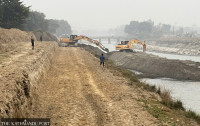National
Two-way trade via Kerung could resume by January first week
But Tatopani border is unlikely to open anytime soon.
Anil Giri
China has decided to resume two-way cargo movement from Rasuwagadhi-Kerung-Jilong port, which was almost shut since the start of the Covid pandemic in early 2020, possibly before the end of the first week of 2023. But the decision is yet to be communicated to the Ministry of Foreign Affairs and Ministry of Industry, Commerce and Supplies.
Speaking at an online function on Thursday, Chargé d'Affaires at the Chinese Embassy in Kathmandu Wang Xin said the two sides are preparing to resume two-way cargo transfer at the Gyirong port, which is also known as Kyirong or Kerung.
Nepali businessmen and traders, who have suffered huge losses due to the disruption in cargo movement, have long been demanding a full-fledged resumption of export and import from the Rasuwagadhi-Kerung-Jilong and Tatopani-Zhangmu border points.
Besides the Rasuwagadhi-Kerung-Jilong point, another key trading point, Tatopani-Zhangmu, is also shut since the start of the pandemic three years ago. Wang did not say when the Tatopani-Zhangmu trading point would reopen. Sources told the Post that China is not willing to immediately resume operations via the Tatopani-Zhangmu point.
For the past 35 months, Nepali businessmen and traders have been importing goods in small quantities through the Rasuwagadhi-Kerung-Jilong border point, while trade through the Tatopani-Zhangmu point remains completely halted.
“At present, the two sides are working to resume two-way cargo movement at the Gyirong Port [Rasuwagadhi-Kerung-Jilong] as soon as possible, and gradually open the Purang Port, which will surely inject new vitality into the economic and trade exchanges between China and Nepal, especially the Tibet-Nepal border-related cooperation,” said Wang. The Chinese port of Purang is located just across the Yari village in Humla district.
Two other officials at the Chinese Embassy also acknowledged that two-way trade through Kerung would soon resume but refused to give an exact date.
A Nepali source who works in close contact with the Chinese Embassy in Nepal said, “Yes, I think the Chinese are in the mood to reopen Keyrung for two-way trade at the earliest. From what I know, two-way trade could resume even before the end of the first week of 2023.”
Officials from Nepal’s foreign, and industry and commerce ministries said they have no formal information on Chinese preparations to resume two-way cargo movement, but it was expected since China has relaxed its “zero-Covid policy” and Covid cases in Tibet have gone down.
Nepali officials at highest levels have long been requesting Beijing to resume full-fledged trade via the two border points.
“We have made several requests to the Chinese side for the resumption of bilateral trade via the two trading points,” said Narayan Prasad Regmi, spokesperson at the Ministry of Industry, Commerce and Supplies. “But we are yet to receive official communication from China about their plans to reopen the Rasuwagadhi-Kerung-Jilong border point.”
“Currently, export to China via the Rasuwagadhi-Kerung-Jilong point is limited as the Nepali side has to ensure sanitization of the goods and this is a rather tardy process,” Regmi added.
Earlier, after closing the Kerung border for over two years owing to the pandemic, China had earlier this year allowed the passage of containers carrying goods imported by Nepali traders for the Dashain festival. The containers had for months been stranded at various places on the Chinese side of the border.
The Nepali customs office at Rasuwagadhi, which would see more than 100 containers cross the border daily before January 2020, said these days around 14 containers pass through the customs point daily. But the movement of people is still prohibited.
Initially, China had closed the border point in early 2020 because of heavy snowfall and the Lhosar festival. However, Covid, which originated in Wuhan of China and was declared a pandemic by the World Health Organisation on March 11, 2020, compelled countries to close their borders and impose lockdowns among other restrictions to prevent the disease from spreading.
The closure of the Rasuwagadhi border continued because of the pandemic. Besides Covid, poor infrastructure on the Nepali side and frequent landslides along the road remain obstacles to using the trading point to its full potential.
After Nepal’s repeated requests, the Chinese side in July had agreed to resume two-way trade through the border point.
During a bilateral consultative meeting between Nepal and China, according to a press statement issued by the Ministry of Foreign Affairs, the two sides had agreed to resume two-way trade through the Rasuwagadhi/Kerung border port, by following Covid health protocol and guidelines.
“With a view to supporting the livelihood of the people in the northern Himalayan region of Nepal, the two sides decided to open the Hilsa/Purang border port for transportation of goods and construction materials from China, by putting in place necessary Covid-19 health protocol and guidelines,” the statement added.
Chinese Chargé d'Affaires Wang also said the two sides will gradually reopen the Yari/Purng port in Humla.
“Although we lack some of the necessary infrastructure on our side, Yari trading point can be used for two-way trade,” said Regmi.
Nepal and China have already agreed to conduct two-way trade via six different border points—Kodari-Nyalam; Rasua-Kerung; Yari (Humla)-Purang; Olangchunggola-Riyo; Kimathanka-Riwo, and Nechung (Mustang)-Legze.




 14.12°C Kathmandu
14.12°C Kathmandu















